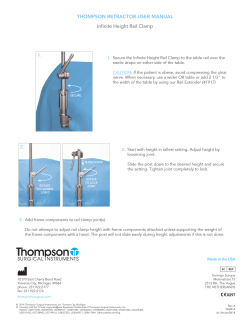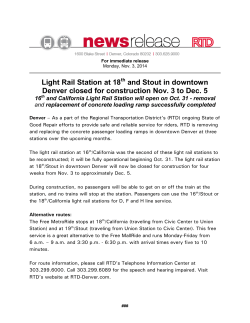
Mar. 2015 Steering & Technical Advisory MINUTES
MINUTES I-26 Fixed Guideway Alternatives Analysis Joint Steering & Technical Advisory Committees Meeting DATE: 3/16/2015 TIME: 2:00 PM LOCATION: BCDCOG (Berkeley-Charleston-Dorchester Council of Governments) ATTENDANCE: See attached Sign-In sheet Agenda: I. II. III. IV. Welcome and Introductions Project Updates a. Public Meetings (November 2014) b. Comprehensive Operational Analysis Update Alternatives Analysis Discussion a. Existing Conditions b. Alternatives Screening c. Land Use Analysis Next Steps/Upcoming Meetings Discussion Comments: 1. The project should include “safety” in the defined goals. Goal #1: “Improve Mobility, Safety, Accessibility and Connectivity of the Transit System and Region”. 2. Suggestion made to also revise Goal #1 to include language that the project seeks to improve the mobility and connectivity within the corridor, to more explicitly address congestion by improving/developing an efficient and competitive transit system. 3. Question was posed to Norfolk Southern (NS) about the current capacity on the NS rail line from Summerville to Charleston and if that capacity might allow for commuter rail along the corridor. NS could not explicitly answer the level of rail activity or the capacity on the Summerville line, but suggested that if the NS rail alignment was selected as the preferred alignment a more detailed study would have to be done to clearly determine how the future rail needs for passenger and freight could be accommodated along the corridor. NS pointed out that it would have to study and take into account the impact of or schedule of higher use/ i-26ALT www.i26alt.org 8/6/12 i-26ALT Page 2 of 3 frequency of lines through the Summerville area that might result from the projected increase in port activity. One known is that currently the NS line out of Summerville is an un-signalized main track. For passenger service to run on any NS line, tracks will have to be signalized to accommodate passenger operations. Again NS stated that projections would have to be completed to determine future levels of service and track needs. A more formal study would have to be undertaken to determine this and would depend on the information needs/requests of the I-26ALT study team. 4. NS was asked what the average timeframe to conduct and complete a study that would answer these questions (current and future rail capacity on line and if excess capacity will allow commuter rail option; as well as the cost to signalize the track along the corridor to allow passenger operations). NS recently completed a similar study in Raleigh, NC which took a little over a year. If the community had the money to undertake a rail study, the process could take anywhere from 12-18 months which accounts for getting the agreement in place, conducting market and future operations forecasting, and includes determining the signalization needs along the corridor. The cost to signalize the line could run somewhere around a couple $100 million (average cost/signal mile). 5. Norfolk Southern was asked if there are inactive lines or if NS right-of-way has allowance for an alternative mode like Bus Rapid Transit (BRT) to operate. NS could not answer the question without the proper research, but suggested that the next step in the process should be a written request from the Study Team that outlines the information needed from Norfolk Southern (signal pricing, right-of-way, track usage, cost of reactivating tracks for use, etc.) 6. The Study Team asked whether Highway 61 had been identified as a possible alignment for fixed guideway. There is a power easement which parallels the road facility that might facilitate BRT service. Suggested that the study group look at this possibility. 7. The next phase of the study is to narrow down the preferred alignments and modes and to evaluate existing land uses in areas where transit stations might be located. The Study Team was asked if there were members of the Committees who are interested in serving on a Land Use Sub-committee of the TAC. Meeting attendees that volunteered include: a. William Peagler, Berkeley County b. Christopher Morgan, City of Charleston c. Andrea Harris-Long, Charleston County d. William Werrell, Joint Base Charleston e. Wannetta Mallette, City of North Charleston 8. Study Team also requested if any members would be able to help engage Boeing and Joint Base Charleston to participate in the employer survey. 8/6/12 i-26ALT Page 3 of 3 9. Committee members were asked to provide comments or questions on the draft technical documents in review (Existing Conditions Technical Memorandum, Alternatives Screening Criteria Methodology, Potential Alternative Alignments Map, Existing Zoning, Land Development & Planning Studies Map, and High Capacity Transit Land Use Analysis Methodology). These documents are posted on the BCDCOG website. 10. Committee members were informed that a set of Transit Talks are being set up to facilitate dialogues among three types of community groups: development, environmental, and business communities. The next series of public meetings are being planned for April 20, 21, and 22. A MindMixer forum for the project should also be coming online in the next few weeks. A copy of the presentation used to facilitate the above discussions is attached to these minutes. Next Meeting June 2015 - TBD
© Copyright 2025





















